Advances in Computer Vision and Pattern Recognition
Ajay Kumar
Contactless
3D Fingerprint
Identification
�
Advances in Computer Vision and Pattern
Recognition
Founding editor
Sameer Singh, Rail Vision, Castle Donington, UK
Series editor
Sing Bing Kang, Microsoft Research, Redmond, WA, USA
Advisory Board
Horst Bischof, Graz University of Technology, Austria
Richard Bowden, University of Surrey, Guildford, UK
Sven Dickinson, University of Toronto, ON, Canada
Jiaya Jia, The Chinese University of Hong Kong, Hong Kong
Kyoung Mu Lee, Seoul National University, South Korea
Yoichi Sato, The University of Tokyo, Japan
Bernt Schiele, Max Planck Institute for Computer Science, Saarbrücken, Germany
Stan Sclaroff, Boston University, MA, USA
�
More information about this series at http://www.springer.com/series/4205
�
Ajay Kumar
Contactless 3D Fingerprint
Identification
123
�
Ajay Kumar
The Hong Kong Polytechnic University
Kowloon, Hong Kong
ISSN 2191-6586
Advances in Computer Vision and Pattern Recognition
ISBN 978-3-319-67680-7
https://doi.org/10.1007/978-3-319-67681-4
ISSN 2191-6594
(electronic)
ISBN 978-3-319-67681-4
(eBook)
Library of Congress Control Number: 2018956591
© Springer Nature Switzerland AG 2018
This work is subject to copyright. All rights are reserved by the Publisher, whether the whole or part
of the material is concerned, specifically the rights of translation, reprinting, reuse of illustrations,
recitation, broadcasting, reproduction on microfilms or in any other physical way, and transmission
or information storage and retrieval, electronic adaptation, computer software, or by similar or dissimilar
methodology now known or hereafter developed.
The use of general descriptive names, registered names,
in this
publication does not imply, even in the absence of a specific statement, that such names are exempt from
the relevant protective laws and regulations and therefore free for general use.
The publisher, the authors and the editors are safe to assume that the advice and information in this
book are believed to be true and accurate at the date of publication. Neither the publisher nor the
authors or the editors give a warranty, express or implied, with respect to the material contained herein or
for any errors or omissions that may have been made. The publisher remains neutral with regard to
jurisdictional claims in published maps and institutional affiliations.
trademarks, service marks, etc.
This Springer imprint is published by the registered company Springer Nature Switzerland AG
The registered company address is: Gewerbestrasse 11, 6330 Cham, Switzerland
�
Preface
Person identification using epidermal ridge impressions from fingers has been
widely studied for over hundred years. It is widely employed in a range of forensic,
e-business and e-governance applications around the world. Traditional acquisition
of fingerprint images by rolling or pressing of fingers against hard surface like glass
or polymer often results in degraded images due to skin deformations, slippages,
smearing or residue of latent from previous impressions. As a result, full potential
from the fingerprint biometric cannot be realized. Contactless 2D fingerprint sys-
tems have emerged to provide improved hygiene and ideal solutions to above
intrinsic problems. Contactless 3D fingerprints can potentially provide significantly
more accurate personal identification, as rich information is available from con-
tactless 3D fingerprint images.
Contactless 3D fingerprints offer exciting opportunities to improve the user
convenience, hygiene and the matching accuracy over the fingerprint biometric
technologies available today. Introduction of videos, or addition of an additional
temporal dimension, was a leap forward that revolutionized the usage of 2D images
in the entertainment, e-governance and e-business. Similarly, the addition of one
more dimension from 3D fingerprints, has potential to significantly alter the way
this biometric is perceived and employed for the civilian and e-governance appli-
cations. Such advancements will not be limited in e-security or e-business, but also
enable dramatic advancements in forensics where the latent or lifted fingerprint
impressions are matched with suspects fingerprint images. For example, the 3D
fingerprints from possible suspects can be employed to simulate latent fingerprint
impressions on a variety of hard or soft real-life materials (door, paper, glass, gun,
etc.) and under variety of pressure, occlusions and deformations, which is expected
to enable more accurate match with the corresponding latent fingerprints that are
lifted from the crime scene. The potential of contactless 3D fingerprints offers
exciting opportunities but requires significant research and development efforts for
its realization.
Availability of a book that is exclusively devoted to the techniques, comparisons
and promises from the contactless 3D fingerprint identification is expected to help
in advancing much needed further research in this area. Some of the contents in this
v
�
vi
Preface
book have appeared in some of our research publications and US patents. However,
many of the important details, explanation and results that have been missed in the
publications are included in this book. The contents in this book attempt to provide
a systematic introduction to the 3D fingerprint
including most
updated advancements in contactless 2D and 3D sensing technologies, and expla-
nation of every important aspect towards the development of an effective 3D fin-
gerprint identification system.
identification,
This book is organized into eight different chapters. Chapter 1 introduces current
trends in the acquisition and identification of fingerprint images. This introductory
chapter discusses the nature of fingerprint impressions and the sensing techniques,
which includes completely contactless 2D fingerprint sensors. This chapter bridges
the journey from rolled and inked fingerprint impressions, to the more advanced
smartphone-based fingerprint sensors, in terms of their resolution and sensing area.
It also provides details on publicly accessible implementations on fingerprint
matchers and most updated list/details on publicly available fingerprint databases
along with respective weblinks to enable easy accessibility.
Chapter 2 in this book presents a range of 3D fingerprint imaging techniques
along with their comparative technical details. Image acquisition methods presented
in this chapter have been grouped into four categories: optical, non-optical, geo-
metric and photometric methods. Details on five different methods to acquire 3D
fingerprint images using stereo vision, pattern lighting, optical coherence tomog-
raphy, ultrasound imaging and photometric stereo, along with potential from other
methods, appear in this chapter.
Chapter 3 in this book is devoted to in-depth details on a low-cost and effective
method for the online 3D fingerprint image acquisition. Systematic details on such
photometric stereo-based setup are detailed in this chapter, i.e. from hardware,
calibration, preprocessing and specular reflection removal, to the choice of recon-
struction methods. This chapter also shares our insights and results on the attempts
made to consider non-Lambertian nature of finger surface. Resulting computational
complexity for such online 3D fingerprint imaging system also appears in this
chapter.
Chapter 4 provides details on more efficient 3D fingerprint imaging approach
using coloured photometric stereo. This approach is introduced to address two key
problems associated with practical 3D fingerprint
involuntary finger
motion and complexity for online applications. This approach revisits the method
detailed in Chap. 3 and contactless 3D fingerprint images acquired using the setup
introduced in this chapter are also publicly made available.
imaging:
Contactless 3D fingerprint data often requires preprocessing operations to sup-
press the accompanying noise and to enhance or accentuate the ridge–valley fea-
tures. Chapter 5 in this book details on such preprocessing operations on the cloud
point 3D fingerprint data. This chapter also provides detailed explanation on spe-
cialized enhanced operations required for the contactless 2D fingerprint images that
are employed for the reconstruction of 3D fingerprints.
�
Preface
vii
Chapter 6 systematically introduces representation of minutiae in 3D space and
provides details on recovering these features from cloud point data. Therefore, the
techniques discussed in this chapter are generalized and quite independent of
method used for the 3D imaging. With the help of many illustrations, most from
real 3D fingerprint data, this chapter systematically details alignment and relative
representation of 3D minutiae in order to generate numerical match score between
two arbitrary 3D fingerprint minutiae templates. This chapter also details a minutiae
selection algorithm and in-depth study on the variation of five-tuple relative 3D
minutiae components with distance, which resulted in the introduction of a unified
matching distance. Detailed experimental results presented in this chapter underline
the effectiveness of our 3D minutiae template-based approach.
Contactless 3D fingerprints can be matched using a range of methods than those
detailed in Chap. 6. Therefore, Chap. 7 details on such efficient 3D fingerprint
matching methods, binary surface code-based approach and its variants, along with
tetrahedron-based matching approach. Methods detailed in this chapter offer
computationally efficient alternatives that can justify their usage in a range of
e-business or civilian applications.
Chapter 8 in this book is devoted for the study on the uniqueness of 3D fin-
gerprints. This chapter scientifically defines the individuality of 3D fingerprints and
comparatively evaluates its improvement, over the 2D fingerprints, using practical
3D minutiae template matching criterion and imaging resolutions. The numbers
illustrated in this chapter provide upper bound on the expected performance from
the contactless 3D fingerprint systems.
I wish to thank many student and staff members in The Hong Kong Polytechnic
University, who have directly or indirectly supported in the completion of this book.
Cyril Kwong and Chenhao Lin deserve special thanks here as they have been
instrumental in advancing many of the research outcome reported in this book.
Cyril has worked with me for several months as research assistant, while Chenhao
has been working towards his doctoral degree research.
Kowloon, Hong Kong
June 2018
Ajay Kumar
�
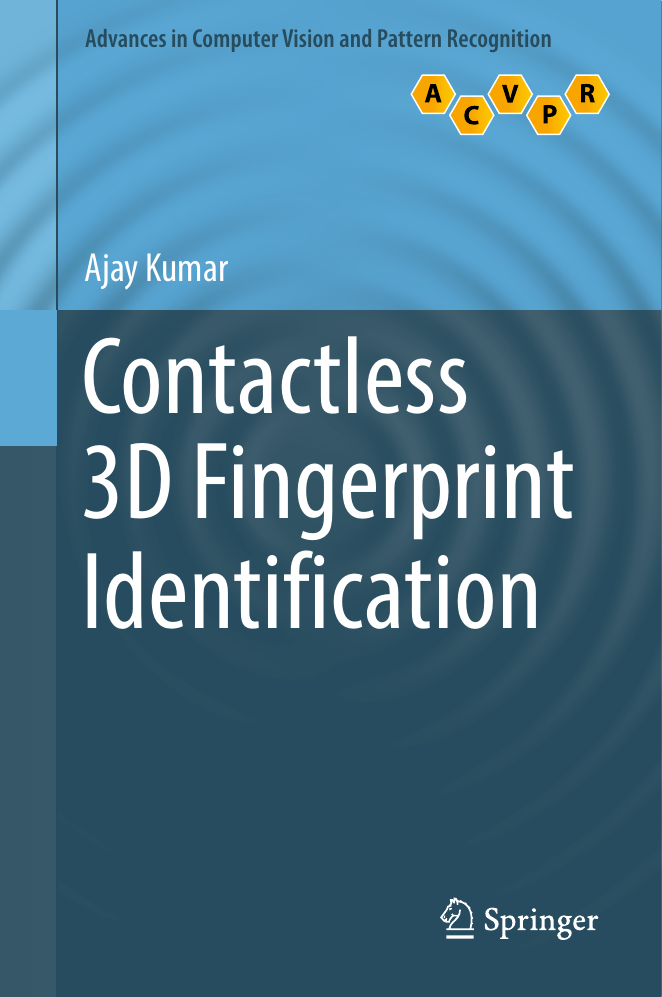


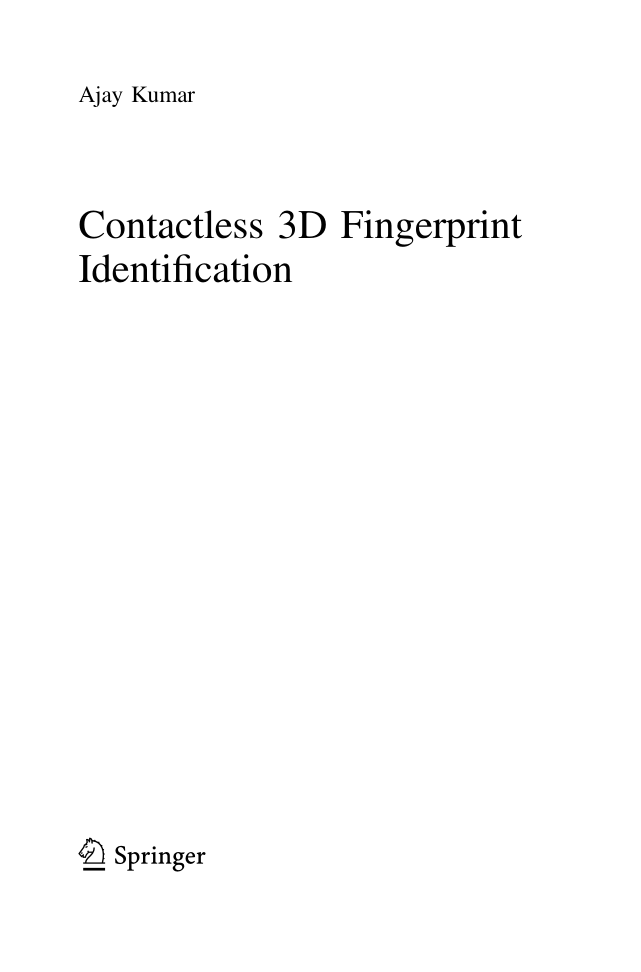
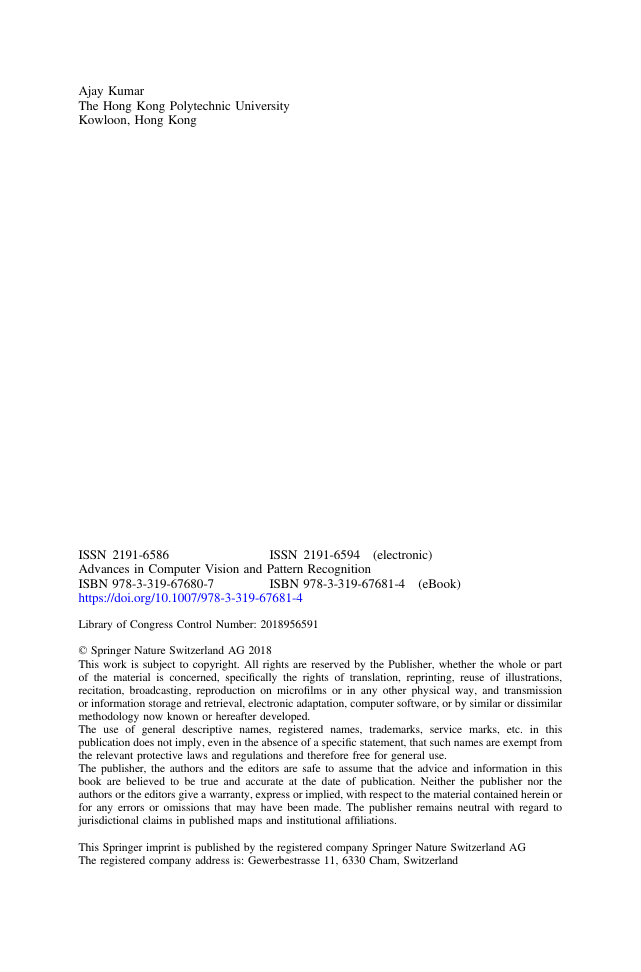
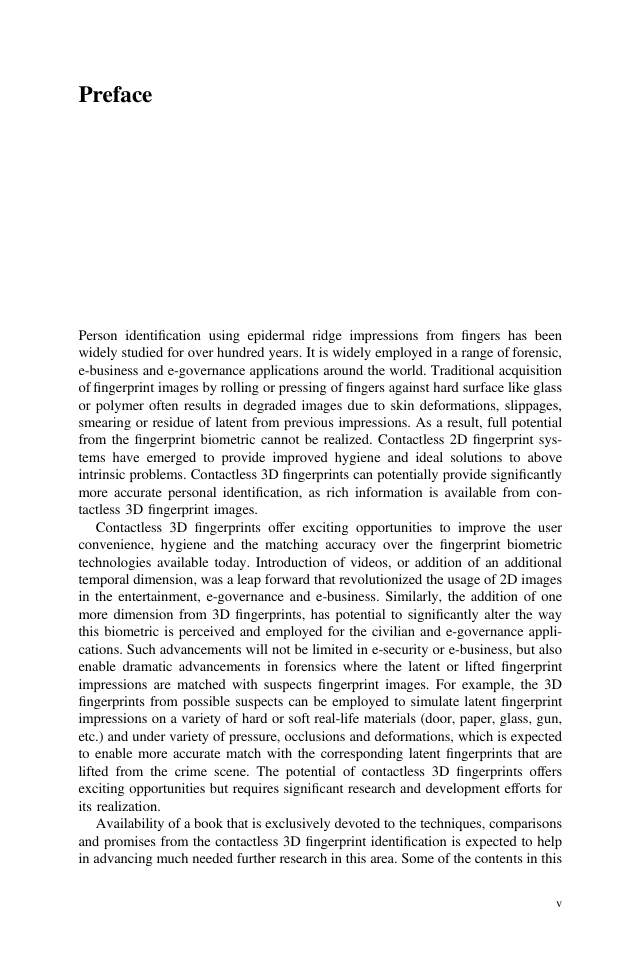
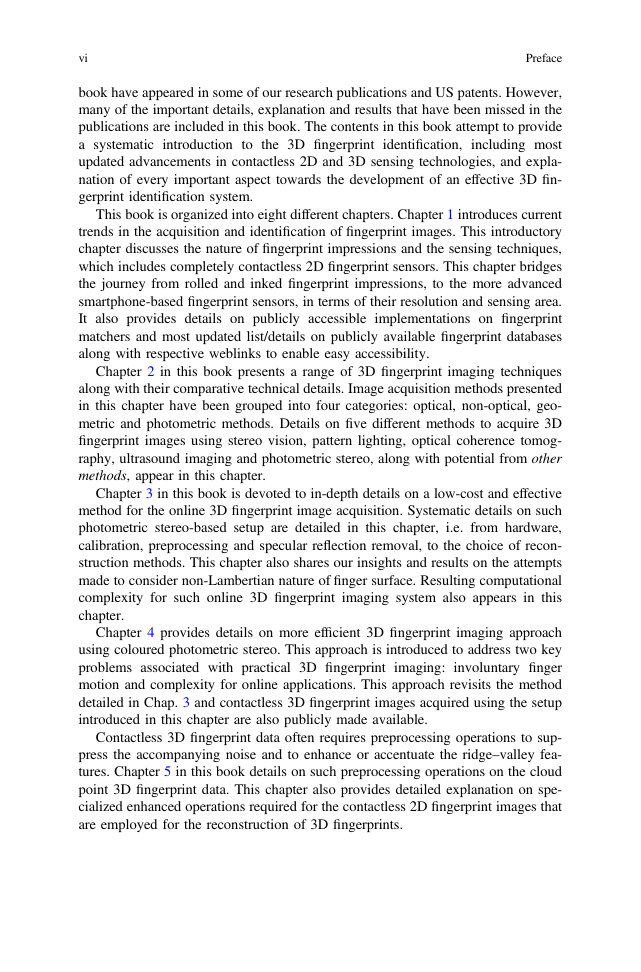
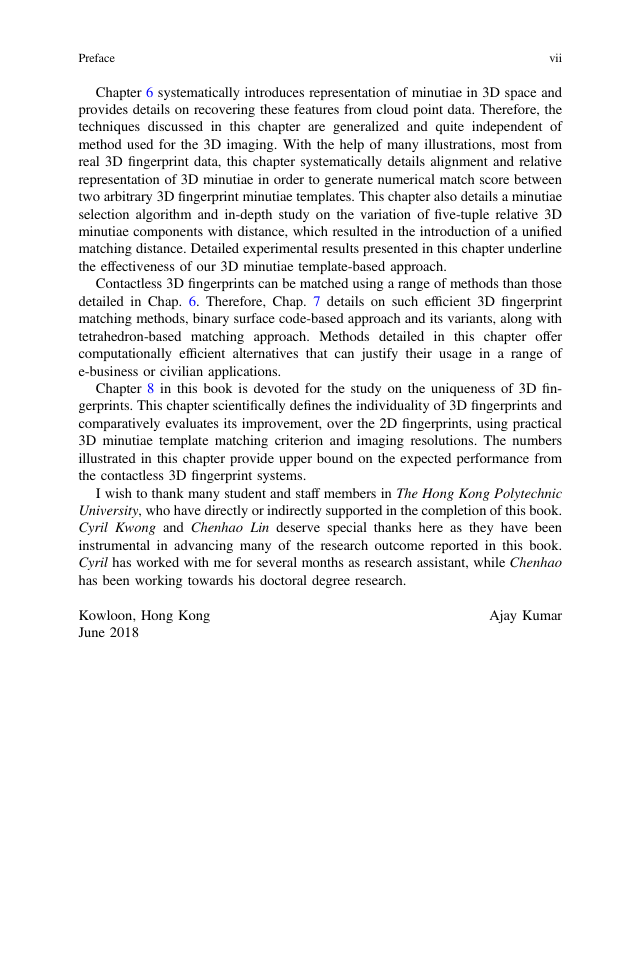








 2023年江西萍乡中考道德与法治真题及答案.doc
2023年江西萍乡中考道德与法治真题及答案.doc 2012年重庆南川中考生物真题及答案.doc
2012年重庆南川中考生物真题及答案.doc 2013年江西师范大学地理学综合及文艺理论基础考研真题.doc
2013年江西师范大学地理学综合及文艺理论基础考研真题.doc 2020年四川甘孜小升初语文真题及答案I卷.doc
2020年四川甘孜小升初语文真题及答案I卷.doc 2020年注册岩土工程师专业基础考试真题及答案.doc
2020年注册岩土工程师专业基础考试真题及答案.doc 2023-2024学年福建省厦门市九年级上学期数学月考试题及答案.doc
2023-2024学年福建省厦门市九年级上学期数学月考试题及答案.doc 2021-2022学年辽宁省沈阳市大东区九年级上学期语文期末试题及答案.doc
2021-2022学年辽宁省沈阳市大东区九年级上学期语文期末试题及答案.doc 2022-2023学年北京东城区初三第一学期物理期末试卷及答案.doc
2022-2023学年北京东城区初三第一学期物理期末试卷及答案.doc 2018上半年江西教师资格初中地理学科知识与教学能力真题及答案.doc
2018上半年江西教师资格初中地理学科知识与教学能力真题及答案.doc 2012年河北国家公务员申论考试真题及答案-省级.doc
2012年河北国家公务员申论考试真题及答案-省级.doc 2020-2021学年江苏省扬州市江都区邵樊片九年级上学期数学第一次质量检测试题及答案.doc
2020-2021学年江苏省扬州市江都区邵樊片九年级上学期数学第一次质量检测试题及答案.doc 2022下半年黑龙江教师资格证中学综合素质真题及答案.doc
2022下半年黑龙江教师资格证中学综合素质真题及答案.doc